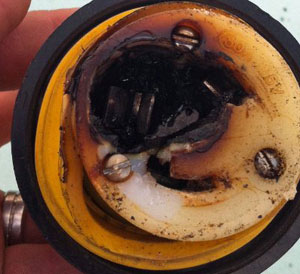Shore Power "Fail Safe." What Does That Mean?
The ABYC now requires galvanic isolators to have fail-safe features in case of a lightning strike or other catastrophic electrical event.
January 17, 2014
Question: I have been getting my boat ready for a long trip south, and the other day I noticed something that I don’t understand related to my shore power system. I hope you can answer my question.

This galvanic isolator on the left conforms to ABYC standards requiring fail-safe features.
The finned box you see in the photo I sent in is of the galvanic isolator on my boat. I think I understand what the galvanic isolator does, preventing my boat’s anodes from contributing to the protection of a neighbor's boat on the same dock. What I don’t understand is the term “fail safe” that’s displayed by the manufacturer, Professional Mariner. Can you explain?
Answer: Sure, it’s a good question. The term "fail-safe" in this application is an engineering term that describes the default failure mode of the isolator in the event of a catastrophic event such as a lightning strike.
It's really important that the integrity of your boat’s grounding system be maintained no matter what, and this system is what ensures that shore power short circuits and ground faults with your onboard AC appliances get back to the source for your shore power on the dock. Ensuring this is what helps minimize electrical shock hazards on board your boat. Galvanic isolators of old could easily fail in an open-circuit mode, and since they are installed in a series with your boat’s green grounding wire, a failure in the open-circuit mode would be the same as cutting the grounding conductor, effectively eliminating the all-important grounding path back to the source of power.
The ABYC electrical committee that oversees the standard that applies here mandated that galvanic isolators be of the fail-safe design five or six years ago. What this means technically is that although the isolator might fail to provide galvanic isolation after a catastrophic event, it will never fail in an open circuit mode, and should maintain its capability of mitigating shock hazards.
One thing is for sure: In the event of a lightning strike to or near your boat, this is a device that should be tested by a qualified ABYC technician to make sure it's still in good operating condition and can still provide galvanic isolation.












